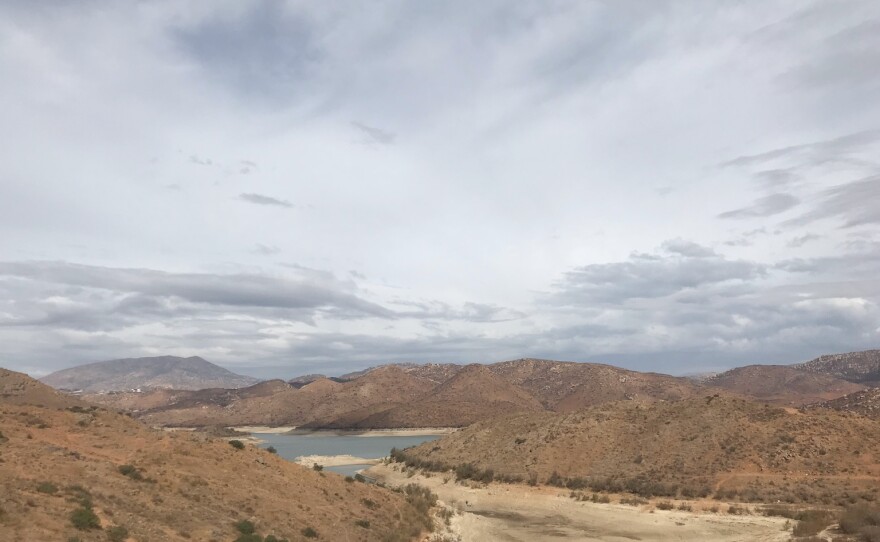Water shutoffs aren’t uncommon in the growing cities of Tijuana and Rosarito. But they’re rarely announced beforehand, and they’re often isolated to certain neighborhoods after pipes or pumps fail.
Earlier this month, however, Tijuana officials announced that it was planning wide-ranging shutoffs for the next two months, in an attempt to replenish a vital reservoir that is perilously low.
“We have to fill up buckets or those big barrels filled with water, or just live off those for a couple of days,” said Jose Sanchez, a tech worker who lives in the Juarez neighborhood of Tijuana. His water was shut off this week.
The shutoffs have been rotating around the city to different neighborhoods, as the government tries to spread the burden of water conservation. The goal is for each neighborhood to have their water shut off for a twenty-four hour period, once every five days.
“We can manage with not washing dishes, maybe ordering more takeout, taking showers with friends and family, for example,” Sanchez said.
RELATED: Climate Change Still Threatens Key US River After Wet Winter
The vast majority of residents don’t drink the water from the tap, but the shutoffs have already impacted the water-use habits of Tijuana.
Ruben Villavicencio Alvarez, who works as an engineer for the city’s water utility, explains that’s part of the idea behind the city-wide shutoffs.
“We’re realizing that for the city to change, ourselves included, we need to make small changes that don’t have a huge impact on us," he told KPBS in Spanish. "But when taken together, end up with really significant savings,”
Alvarez said that residents are realizing that by making small changes to their lifestyles, like taking shorter showers, the city can make a huge change to its water use. He said it’s already seeing results.
But after an especially wet winter, why is Tijuana suddenly low on water?
It has to do with where the city’s water is coming from. A few miles from water department headquarters lies the El Carrizo Reservoir, which supplies the city with the majority of its water.
Vegetation marks the reservoirs normal level, which is now several dozen feet above the stagnant water below. Right now, the reservoir is only at 15% of capacity. It supplies most of the water for Tijuana and Rosarito.
“More than 90% of the water in the coastal zone, and that would be Rosarito, and Tijuana and Tecate, comes from the Colorado River,” said SDSU professor Paul Ganster, who has studied water use along the border for decades.
Water first crosses into Mexico to the west of Mexicali, where it’s used mostly for agriculture. To reach Tijuana’s reservoir, it has to be pumped uphill through an aqueduct system that runs over the Sierra Juarez.
It’s that trip that's left Tijuana dry.
“It’s a thin lifeline, it’s one that’s vulnerable to a number of things,” said Ganster.
Over the past few months, a series of pump failures have limited the supply of water over the mountains to Tijuana. On top of that, agricultural interests in the Mexicali Valley have upped their consumption of water during the hot, dry summer. As a result, the water in the local reservoirs has dropped below a level where water can be efficiently processed.
“The normal intake is not at the bottom of the reservoir, but actually up some distance above that in order to not suck up sediments at the bottom. So if they don’t have water to put into the system, they’re just stuck,” said Ganster.
The water crisis in Baja coincides with a change in government from the conservative PAN Party, which had ruled the state for 30 years, to the ascendant Morena party, which in a few years has seized power across the country on the promise to crack down on corruption.
Morena officials lay the blame for the water shortage on the previous administration, pointing at millions of missing pesos that were supposed to go towards improved infrastructure.
Jose Sanchez, the tech worker who’s filling up buckets every few days, said part of the city’s candor about the water shortage can be chalked up to not being directly responsible for the current problem.
“People are angry at the situation. They’re not yet angry at the new government. Maybe a year from now it’s going to change. Depends on their tone, depends on how they handle everything,” said Sanchez.
With Tijuana continuing to grow, water conservation is going to become vital. And if a rare wet winter can still lead to a shortage, Tijuana has little time to prepare for the West Coast's longer and more frequent droughts as part of the changing climate.







